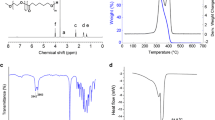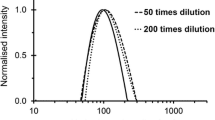Abstract
Purpose
To study a non-invasive method of using contrast enhanced magnetic resonance imaging (MRI) to visualize the real-time pharmacokinetics, biodistribution and tumor accumulation of paramagnetically labeled poly[N-(2-hydroxypropyl)methacrylamide] (PHPMA) copolymer conjugates with different molecular weights and spacers in tumor-bearing mice.
Materials and Methods
Paramagnetically labeled HPMA copolymer conjugates were synthesized by free radical copolymerization of HPMA with monomers containing a chelating ligand, followed by complexation with Gd(OAc)3. A stable paramagnetic chelate, Gd-DO3A, was conjugated to the copolymers via a degradable spacer GlyPheLeuGly and a non-degradable spacer GlyGly, respectively. The conjugates with molecular weights of 28, 60 and 121 kDa and narrow molecular weight distributions were prepared by fractionation with size exclusion chromatography. The conjugates were injected into athymic nude mice bearing MDA-MB-231 human breast carcinoma xenografts via a tail vein. MR images were acquired before and at various time points after the injection with a 3D FLASH sequence and a 2D spin-echo sequence at 3T. Pharmacokinetics, biodistribution and tumor accumulation of the conjugates were visualized based on the contrast enhancement in the blood, major organs and tumor tissue at various time points. The size effect of the conjugates was analyzed among the conjugates.
Results
Contrast enhanced MRI resulted in a real-time, three-dimensional visualization of blood circulation, pharmacokinetics, biodistribution and tumor accumulation of the conjugates, and the size effect on these pharmaceutical properties. HPMA copolymer conjugates with high molecular weight had a prolonged blood circulation time and high passive tumor targeting efficiency. Non-biodegradable HPMA copolymers with molecular weights higher than the threshold of renal filtration demonstrated higher efficiency for tumor drug delivery than biodegradable poly(L-glutamic acid).
Conclusions
Contrast enhanced MRI is an effective method for non-invasive visualization of in vivo properties of the paramagnetically labeled polymer conjugates in preclinical studies.






Similar content being viewed by others
References
J. Kopecek, P. Kopeckova, T. Minko, and Z.-R. Lu. HPMA copolymer-anticancer drug conjugates: design, activity, and mechanism of action. Eur. J. Pharm. Biopharm. 50:61–81 (2000).
B. Rihova and K. Kubackova. Clinical implications of N-(2-hydroxypropyl)methacrylamide copolymers. Curr. Pharm. Biotechnol. 4:311–322 (2003).
H. Maeda, L. W. Seymour, and Y. Miyamoto. Conjugates of anticancer agents and polymers: advantages of macromolecular therapeutics in vivo. Bioconjug. Chem. 3:351–362 (1992).
R. Haag and F. Kratz. Polymer therapeutics: concepts and applications. Angew. Chem. Int. Ed. Engl. 45:1198–1215 (2006).
Z.-R. Lu, J.-G. Shiah, P. Kopeckova, and J. Kopecek. Polymerizable Fab’ antibody fragments targeted photodynamic cancer therapy in nude mice. STP Pharm. Sci. 13:69–75 (2003).
M. V. Pimm, A. C. Perkins, J. Strohalm, K. Ulbrich, and R. Duncan. Gamma scintigraphy of the biodistribution of 123I-labelled N-(2-hydroxypropyl)methacrylamide copolymer-doxorubicin conjugates in mice with transplanted melanoma and mammary carcinoma. J. Drug Target. 3:375–383 (1996).
P. J. Julyan, L. W. Seymour, D. R. Ferry, S. Daryani, C. M. Boivin, J. Doran, M. David, D. Anderson, C. Christodoulou, A. M. Young, S. Hesslewood, and D. J. Kerr. Preliminary clinical study of the distribution of HPMA copolymers bearing doxorubicin and galactosamine. J. Control Release. 57:281–290 (1999).
M. Kissel, P. Peschke, V. Subr, K. Ulbrich, J. Schuhmacher, J. Debus, and E. Friedrich. Synthetic macromolecular drug carriers: biodistribution of poly[(N-2-hydroxypropyl)methacrylamide] copolymers and their accumulation in solid rat tumors. PDA J. Pharm. Sci. Technol. 55:191–201 (2001).
A. Mitra, A. Nan, H. Ghandehari, E. McNeill, J. Mulholland, and B. R. Line. Technetium-99m-Labeled N-(2-hydroxypropyl) methacrylamide copolymers: synthesis, characterization, and in vivo biodistribution. Pharm. Res. 21:1153–1159 (2004).
M. V. Pimm, A. C. Perkins, J. Strohalm, K. Ulbrich, and R. Duncan. Gamma scintigraphy of a 123I-labelled N-(2-hydroxypropyl)methacrylamide copolymer-doxorubicin conjugate containing galactosamine following intravenous administration to nude mice bearing hepatic human colon carcinoma. J. Drug Target. 3:385–390 (1996).
D. Wang, S. C. Miller, M. Sima, D. Parker, H. Buswell, K. C. Goodrich, P. Kopeckova, and J. Kopecek. The arthrotropism of macromolecules in adjuvant-induced arthritis rat model: a preliminary study. Pharm. Res. 21:1741–1749 (2004).
F. Ye, T. Ke, E.-K. Jeong, X. Wang, Y. Sun, M. Johnson, and Z.-R. Lu. Noninvasive visualization of in vivo drug delivery of poly(L-glutamic acid) using contrast-enhanced MRI. Mol. Pharmaceutics. 3:507–515 (2006).
K. Ulbrich, V. Subr, J. Strohalm, D. Plocova, M. Jelinkova, and B. Rihova. Polymeric drugs based on conjugates of synthetic and natural macromolecules. I. Synthesis and physico-chemical characterisation. J. Control Release. 64:63–79 (2000).
T. Ke, Y. Feng, J. Guo, D. L. Parker, and Z.-R. Lu. Biodegradable cystamine spacer facilitates the clearance of Gd(III) chelates in poly(glutamic acid) Gd-DOTA conjugates for contrast enhanced MR imaging. Magn. Reson. Imaging. 24:931–940 (2006).
T. Kaneshiro, T. Ke, E. K. Jeong, D. L. Parker, and Z.-R. Lu. (Gd-DTPA)-(L-cystine bisalkylamide) copolymers as novel biodegradable macromolecular contrast agents for MR blood pool imaging. Pharm. Res. 23:1285–1294 (2006).
Y. Feng, Y. Zong, T. Ke, and Z.-R. Lu. Pharmacokinetics and blood pool contrast enhancement of Gd-DTPA cystine copolymers and Gd-DTPA cystine diethyl ester copolymers. Pharm. Res. 23:1736–1742 (2006).
P. Caravan, J. J. Ellison, T. J. McMurry, and R. B. Lauffer. Gadolinium(III) chelates as MRI contrast agents: structure, dynamics, and applications. Chem. Rev. 99:2293–2352 (1999).
X. Wang, Y. Feng, T. Ke, M. Schabel, and Z.-R. Lu. Pharmacokinetics and tissue retention of (Gd-DTPA)-cystamine copolymers, a biodegradable macromolecular magnetic resonance imaging contrast agent. Pharm. Res. 22:596–602 (2005).
P. L. Choyke, A. J. Dwyer, and M. V. Knopp. Functional tumor imaging with dynamic contrast-enhanced magnetic resonance imaging. J. Magn. Reson. Imaging. 17:509–520 (2003).
F. M. Veronese, O. Schiavon, G. Pasut, R. Mendichi, L. Andersson, A. Tsirk, J. Ford, G. Wu, S. Kneller, J. Davies, and R. Duncan. PEG-doxorubicin Conjugates: Influence of Polymer Structure on Drug Release, in Vitro Cytotoxicity, Biodistribution, and Antitumor Activity. Bioconjug. Chem. 16:775–784 (2005).
L. W. Seymour, Y. Miyamoto, H. Maeda, M. Brereton, J. Strohalm, K. Ulbrich, and R. Duncan. Influence of molecular weight on passive tumour accumulation of a soluble macromolecular drug carrier. Eur. J. Cancer. 31A:766–770 (1995).
P. Rejmanova, J. Kopecek, R. Duncan, and J. B. Lloyd. Stability in rat plasma and serum of lysosomally degradable oligopeptide sequences in N-(2-hydroxypropyl) methacrylamide copolymers. Biomaterials. 6:45–48 (1985).
D. R. Messroghli, S. Plein, D. M. Higgins, K. Walters, T. R. Jones, J. P. Ridgway, and M. U. Sivananthan. Human myocardium: single-breath-hold MR T1 mapping with high spatial resolution-reproducibility study. Radiology. 238:1004–1012 (2006).
E. L. So. Integration of EEG, MRI, and SPECT in localizing the seizure focus for epilepsy surgery. Epilepsia. 41(Suppl 3):S48–S54 (2000).
M. D. Seemann. Whole-body PET/MRI: the future in oncological imaging. Technol. Cancer Res Treat. 4: 577–582 (2005).
S. W. Zielhuis, J. H. Seppenwoolde, V. A. Mateus, C. J. Bakker, G. C. Krijger, G. Storm, B. A. Zonnenberg, A. D. Schip, G. A. Koning, and J. F. Nijsen. Lanthanide-loaded liposomes for multimodality imaging and therapy. Cancer Biother. Radiopharm. 21:520–527 (2006).
J. G. Shiah, M. Dvorak, P. Kopeckova, Y. Sun, C. M. Peterson, and J. Kopecek. Biodistribution and antitumour efficacy of long-circulating N-(2-hydroxypropyl)methacrylamide copolymer-doxorubicin conjugates in nude mice. Eur. J. Cancer. 37:131–139 (2001).
Acknowledgments
This research was supported in part by NIH grant R01 CA097465. We thank Ms. Melody Johnson for the technical help in MRI data acquisition.
Author information
Authors and Affiliations
Corresponding author
Rights and permissions
About this article
Cite this article
Wang, Y., Ye, F., Jeong, EK. et al. Noninvasive Visualization of Pharmacokinetics, Biodistribution and Tumor Targeting of Poly[N-(2-hydroxypropyl)methacrylamide] in Mice Using Contrast Enhanced MRI. Pharm Res 24, 1208–1216 (2007). https://doi.org/10.1007/s11095-007-9252-1
Received:
Accepted:
Published:
Issue Date:
DOI: https://doi.org/10.1007/s11095-007-9252-1




